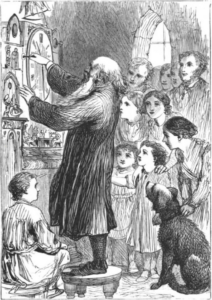Tick Tock, Tick Tock – Ways to Wind Your Narrative Clock

Mom and I had similar hairdos.
Eons ago, when I was seven, I pretended to choke to death when my mother lit up a cigarette near me. I grabbed my throat, made wheezing, chortling sounds, and fell to the floor, writhing and flailing until I expelled a final “ahhhhh” and dropped my head sideways. I was trying to break Mom of her smoking habit.
Mom, however, was trying to break me of disrespecting her. Peeking through one eye, I waited for her reaction. Cigarette in hand, she said, “I’m taking your sisters to McDonald’s, but you’ll stay here and reflect on your behavior.” I bolted upright, thinking she’d never leave me home alone, since I often “got into things.”
“Are you sure about leaving her here?” my older sister sneered.
Mom smiled as she arched her eyebrows, and off they went. Oh joy! What first? Dress up my cats (against their wills, obviously)? Eat all the leftover meatloaf? Boogie to my sisters’ treasured (and off-limits) 45-rpm records?
Five minutes later, someone broke into our house. From upstairs, I heard the front door close. I started down the stairs, thinking Mom had changed her mind. But standing in the living room was a heavily built man who looked remarkably similar to the guy who had dated, and then beaten, our neighbor.
He didn’t look my way. So, being the impertinent, fearless soul that I was, I dashed to my room and dove under my bed. I huddled in the dark shadows, my heart hammering.
I heard doors and drawers banging and slamming below. Footsteps raced up the stairs; more drawer noise resounded.
Black shoes entered my room. Surely the burglar would look under my bed. My hands smothered my mouth to stifle my whimpering and frantic breathing. My body shivered like when I battled a bad fever. Unlike earlier, this time I wasn’t faking it.
As I stared at those shoes, time stopped. Every second was an eternity. Tears slid down my cheeks and onto my hands.
Then the shoes were gone. I didn’t move. Forever passed.
Then came Mom’s voice: “Oh, dear God!”
Then immediately: “Gail! Gail, where are you?”
Time launched again. It flew like a flash as Mom and my sisters sprinted around the house shouting my name. I still couldn’t move, but I wasn’t crying silently anymore. I was sobbing convulsively. Mom’s knees landed on the floor beside the bed, and despite my distress, I marveled at how fast she’d kneeled with her arthritic back and legs. Her face, appearing inches from mine, was a contrast of terror and joy. She said, “Come here, baby.”
“What took you so long?” I bleated, my stomach knotting as my mind queried if I was safe. “It’s been hours!”
Except it hadn’t been. McDonald’s was a five-minute drive from our house, and Mom had ordered takeout. Later, she told me they’d only been gone fifteen minutes. The time needed for Mom to bake and cool a batch of Toll House cookies. But it was also the time needed for a thief to enter our home and take hidden cash plus Dad’s watches, cufflinks, and fraternal rings. The time needed to make a clean getaway.
Unlike space and matter, time can be befuddling, incomprehensible. Science journalist and author Dan Falk, in his 2020 Quanta Magazine article titled “Arrows of Time,” states: “The human mind has long grappled with the elusive nature of time: what it is, how to record it, how it regulates life, and whether it exists as a fundamental building block of the universe.” To a seven-year-old, its instability can feel traumatic. After the burglary, I became acutely aware of time’s slippery essence, especially during occasions of high excitement, joy, fear, or tension. I related time’s slow ticking – that involuntary stretching – to the holding of my breath and the dizzy, disconnected feeling of floating. I associated time’s fast flight – that roller coaster plunge – with muscle cramps and a thumping heart.
As I grew older, and perhaps due to my childhood scare, I continued to feel time’s insistent presence as I experienced it both as the person upon whom time was thrust (“The due date’s when?!”) and as an observer watching myself react (“Why do my legs feel like noodles?”). Within my family, I noticed how we processed time differently, even in shared situations.

Drawing by H.W. Petherick
When I began writing fiction, a genre in which time isn’t real and everything’s a movement or immobilization in time, I tossed a nod at my mysterious companion – who I’d personified as an old man with long white hair – and Father Time jumped into my work. Together we played and experimented. But it wasn’t until I started my MFA in Writing for Children and Young Adults (YA) program, and began reading dozens of books, that I discerned the important reasons why authors place time elements in their stories: to create tension, set pace, develop characters through flashbacks, elongate or condense story lines, freeze time to add exposition, and more. My all-time favorite function was building (and releasing and rebuilding) tension.
I wrote more stories, with a better appreciation of time’s roles. I learned that while child comprehension studies vary, many agree that children start to truly understand time passage at seven to eight years old. This convinced me that middle grade (MG) and YA stories and novels are excellent mediums for authors who utilize time elements, especially as intensifiers.
One of the best qualities of Madeleine L’Engle’s MG novel A Wrinkle in Time is how she compacted time to accelerate travel duration. By twisting a mathematical concept, she created “tessering” (which involves accessing the fourth and fifth dimensions). Now, her protagonist, Meg, could expeditiously traverse the universe as she searched for her missing father. But tessering is difficult and frightening, which induces reader anxiety. L’Engle describes Meg’s reaction during this process: “Coming as a complete and unexpected shock, [Meg] felt a pressure she had never imagined, as though she were being completely flattened out by an enormous steam roller.” What’s more, condensing the travel time allowed the story’s pace to quicken (more tension) as the plot points highlighted the father-saving efforts. In my first MG fantasy novel, I copied L’Engle’s time-escalation construct to instantly fling an embittered eleven-year-old into a parallel world and trap him there. I was then able to advance to the scenes where he becomes disoriented and distraught because in that place, time literally speeds up and slows down.
Frequently authors use a time technique that is constrictive and terrifying in how it plays out scene by scene: the “ticking clock plot device,” which forces characters to race against time. Glen Strathy, adult and children’s books writer, describes this strategy in “Ticking Clock or Option Exhaustion: 2 Ways To Bring Your Novel To A Crisis”: “The technique…give[s] the protagonist a set amount of time by which to achieve the Story Goal or else suffer the Consequence. Generally, you create tension by not allowing your protagonist to achieve the goal until the very last second (which is also the crisis of the story).” Using this device, the writer places the notice of a time-related limitation somewhere in the story and afterwards, by words or action, shows time’s passage and/or how much time is left. Strathy suggests compounding the protagonist’s problems as the time elapses, since this “makes the reader increasingly concerned whether the problem will be solved in time.”

Photo Credit: Sherry White
I love how Michael Grant’s narrative clock ticks tenaciously toward disaster in his YA dystopian novel Gone. Everyone over the age of 14 suddenly disappears within a 10-mile radius of a small town. Those remaining are encased within an impenetrable dome, and they believe they’ll also disappear when they turn 15. Grant overtly keeps the time-tension running by titling each chapter heading with the number of hours and minutes left before the main character, Sam, turns 15 (e.g., Chapter One: 299 Hours, 54 Minutes; Chapter Forty-Six: 01 Minutes). This forces readers to participate in the countdown as they proceed to each chapter. Grant’s dialogue also keeps readers connected as they read forward to see if Sam can find a way to escape or survive and defeat his enemy before his fifteenth birthday. For instance, in Chapter Seven, readers find out exactly how much time Sam has left before that day: “Twelve days from now. No, just eleven days now, since it’s after midnight.” Informed and inspired by Grant, I wrote a science fiction story about an unassuming young director who must prove her mettle by finding the source and cure for her sudden mental instability before her boss detects it, or worse, it kills her.
There are so many ways to amp up the voltage in fiction, and Ibi Zoboi does an outstanding job of harnessing numerous time elements to create and control tension in her YA novel American Street. Time continually appears to interweave central themes, such as immigration, separation, identity, growing up, and love. The story unfolds in a short time span – about three months – which welds urgency to the need to resolve the presented conditions and conflicts. In the beginning, sixteen-year-old Fabiola enters the U.S. with her mother after leaving their home in Haiti. U.S. Immigration detains the mother for previously overstaying her visa (a time issue), which triggers Fabiola’s anxious book-long wait for her mother’s release. As Fabiola adjusts to her U.S. world, she flashes back to her Haitian life. These flashbacks slow the pace, but add character development vital for later fast-moving scenes. When Fabiola asks her spiritual guides to bend time and space between her and her mother, this implants intrigue and suspense. Time is even used to paint Fabiola’s love story: “I can’t wipe the smile from my face, even as the time stretches thin and wide without another word being exchanged.” At every turn, time impacts the characters. As a reader, I acutely felt time’s constant strikes.
While I don’t write magical realism like Zoboi, I adopted her recurrent use of time to keep tension active and rising. In my YA horror story, a rebellious teenager first faces getting through a weekend of compulsory camping. Soon she finds herself waiting anxiously for the next assault from a relentless bully. But the real terror occurs when she has only minutes to contain her adrenalized fear and determine how to outwit and escape from a monstrous creature intent on consuming her.
As I continue to explore time elements in my work, I sometimes reflect on the long-ago burglary. In the years hence, I’ve filled my time with intention and purpose. I’ve escaped time by reading, writing, and watching movies. I’ve repeatedly heard and experienced time’s metered beats through countless time-slowing and -accelerating moments. My experiences taught me that time is not absolute. It can begin and end anywhere. It can impact every aspect of life. In my fiction writing, I relish how I can move time forward and backwards at any assigned speed, or even freeze it in place. For me, time is the perfect writer’s tool to give my MG/YA plots, characters, and readers some chills and thrills.

Photo Credit: rbd.gif at tenor.com
Mom thought I’d be okay when she briefly left me home alone. She was living a hurried life, raising three spunky girls, teaching English, and managing the family business. When we acted up, she’d blurt out, “I don’t have time for this!” Sometimes, she wished she could stop time to get more things done.
What she didn’t comprehend was that stopping time creates all kinds of dramatic difficulties, which is what I’m realizing as I draft my new MG novel. You see, there are these dirty rotten Timelifters who discover how to swipe bits of time from people and sell them for a fortune. But for victims like eleven-year-old Marta, life halts until the stolen moments pass. And as Marta can affirm, it’s no fun when chunks of your life go missing and you suddenly find yourself trembling beneath your bed while a stranger ransacks your home.
Thanks Mom.
Gail Vannelli retired from a career as an attorney in 2016 and actively pursued fiction writing, mostly in the MG and YA genres. She has her MFA in Writing for Children and Young Adults from Vermont College of Fine Arts, and her Post-MFA Certificate in the Teaching of Creative Writing from Antioch University Los Angeles. She is an industry news reporter and writer for Cynsations and is an interviewer, blogger, and assistant editor for Lunch Ticket.





